An Experimental Study of the Road Performance of Cement Stabilized Coal Gangue
Abstract
:1. Introduction
2. Raw Materials
2.1. Coal Gangue
2.2. Crushed Stone
2.3. Cement
3. Test Method
3.1. Gradation Optimization
3.2. Compaction Test
3.3. Unlateral Limited Compressive Strength Test
3.4. Splitting Tensile Strength Test
3.5. Freeze–Thaw Resistance Test
3.6. Drying Shrinkage Test
4. Test Results and Data Discussion
4.1. Gradation Optimization Design
4.2. Compaction Test
4.3. 7-Day Unconfined Compressive Strength
4.4. Splitting Tensile Strength of Cement Stabilized Coal Gangue
4.5. Freeze–Thaw Resistance Test of Cement Stabilized Coal Gangue
4.6. Drying Shrinkage Test
5. Conclusions
- (1)
- Coal gangue was prepared by a sorting and crushing process, and the grading of coal gangue raw materials was optimized by a power function model. The prepared cement stabilized coal gangue pavement base material with 4% cement content had a 7-day unconfined compressive strength of 2.3 MPa, a 90-day splitting tensile strength of 0.87 MPa, a frost resistance index BDR of 75.16%, a mass loss rate of 0.07%, and a 31-day dry shrinkage strain of 627.5 × 10−6, which can be used for medium and light traffic bases and the heavy traffic subbase of class II and below highways.
- (2)
- The test results show that the cement content and the grading of the coal gangue raw materials are the main factors affecting the 7-day unconfined compressive strength of the cement stabilized coal gangue. An increase in cement content can improve the 90-day splitting tensile strength of cement stabilized coal gangue. Cement content and moisture content are the key factors affecting the frost resistance index of cement stabilized coal gangue. The larger the cement content is, the larger the dry shrinkage strain of cement stabilized coal gangue is, and the shrinkage strain decreases first and then increases with an increase in age.
- (3)
- In view of the possible problems of cement stabilized coal gangue as a pavement base, the comprehensive experimental analyses were carried out to verify the feasibility of cement stabilized coal gangue as a highway base and subbase.
Author Contributions
Funding
Data Availability Statement
Conflicts of Interest
References
- Bian, Z.; Dong, J.; Lei, S.; Leng, H.; Mu, S.; Wang, H. The iMpact of disposal and treatment of coal mining wastes on environment and farmland. Environ. Geol. 2009, 58, 625–634. [Google Scholar] [CrossRef]
- Duan, X.; Xia, J.; Yang, J. Influence of coal gangue fine aggregate on microstructure of cement mortar and its action mechanism. J. Build. Mater. 2014, 17, 700–705. [Google Scholar]
- Ma, J.; Yu, Z.M.; Shu, S.H.; Zeng, Z.H. University G. Environmental Hazards of Coal Gangue and the Control Measures. Coal Eng. 2015, 47, 70–73. [Google Scholar]
- Liu, H.; Liu, Z. Recycling utilization patterns of coal mining waste in China. Resour. Conserv. Recycl. 2010, 54, 1331–1340. [Google Scholar]
- Gong, C.; Yan, J.; Liu, J.; Huaijun, Y.U. Biology Migration and Distribution Characteristics of Trace Elements in Reconstructed Soil with Coal Gangue Filling. Agric. Sci. Technol. 2016, 46, 189–192. [Google Scholar]
- Wang, S.; Luo, K.; Wang, X.; Sun, Y. Estimate of sulfur, arsenic, mercury, fluorine emissions due to spontaneous combustion of coal gangue: An important part of Chinese emission inventories. Environ. Pollut. 2016, 209, 107–113. [Google Scholar] [CrossRef]
- Qin, J.; Zhao, R.; Chen, T.; Zi, Z.; Wu, J. Co-combustion of municipal solid waste and coal gangue in a circulating fluidized bed combustor. Int. J. Coal Sci. Technol. 2019, 6, 218–224. [Google Scholar] [CrossRef] [Green Version]
- Mog, H.; Adam, M.J.; Ajalloeian, R.; Hajiannia, A. Preparation and application of alkali-activated materials based on waste glass and coal gangue: A review. Constr. Build. Mater. 2019, 221, 84–98. [Google Scholar]
- Skaryńska, K.M. Reuse of coal mining wastes in civil engineering—Part 2: Utilization of minestone. Waste Manag. 1995, 15, 83–126. [Google Scholar] [CrossRef]
- Marland, S.; Han, B.; Merchant, A. The effect of microwave radiation on coal grindability. Fuel 2000, 79, 1283–1288. [Google Scholar] [CrossRef]
- Sripriya, R.; Rao, P.; Choudhury, B.R. Optimisation of operating variables of fine coal flotation using a combination of modified flotation parameters and statistical techniques. Int. J. Miner. Process. 2003, 68, 109–127. [Google Scholar] [CrossRef]
- Li, W.X.; Wang, D.L.; Niu, J.S.; Ma, X.W. Preparation of Coal Gangue Cement Mortar. Adv. Mater. Res. 2013, 684, 159–162. [Google Scholar] [CrossRef]
- Dong, Z.; Xia, J.; Fan, C.; Cao, J. Activity of calcined coal gangue fine aggregate and its effect on the mechanical behavior of cement mortar. Constr. Build. Mater. 2015, 100, 63–69. [Google Scholar] [CrossRef] [Green Version]
- Qiu, Y.L.; Zhang, X.X.; Liu, K.P.; Hu, X.Y.; Guan, B.W. Research on Mechanical Behaviour of Cement Mortar with High-Volume Coal Gangue. Adv. Mater. Res. 2011, 261–263, 685–689. [Google Scholar] [CrossRef]
- Qin, B.; Ji, Y.; Bai, Z.; Zhao, Q. Research on mechanical behavior of calcined coal gangue cement mortar with different chemical activators. In Proceedings of the 2017 3rd International Forum on Energy, Environment Science & Materials, Shenzhen, China, 25–26 November 2017; Atlantis Press: Amsterdam, The Netherlands, 2018; pp. 653–656. [Google Scholar]
- Wang, H.; Amp, Y.V. Research on the Freeze-thaw Damage Law of Coal Gangue Concrete. Fly Ash Compr. Util. 2019, 2, 42–45. [Google Scholar]
- Zheng, Y.; Zhang, P.; Cai, Y.; Jin, Z.; Moshtagh, E. Cracking resistance and mechanical properties of basalt fibers reinforced cement-stabilized macadam. Compos. Part B Eng. 2019, 165, 312–334. [Google Scholar] [CrossRef]
- Huang, M.; Duan, J.; Wang, J. Research on Basic Mechanical Properties and Fracture Damage of Coal Gangue Concrete Subjected to Freeze-Thaw Cycles. Adv. Mater. Sci. Eng. 2021, 7, 1–12. [Google Scholar]
- Chen, Y.; Niu, W.; Ding, Z. Research on Elastic Modulus of Gangue Concrete. In Proceedings of the 14th International Congress on the Chemistry of Cement ICCC, Beijing, China, 13–16 October 2015. [Google Scholar]
- Guan, J.; Li, Q.; Wu, Z.; Zhao, S.; Dong, W.; Zhou, S. Minimum specimen size for fracture parameters of site-casting dam concrete. Constr. Build. Mater. 2015, 93, 973–982. [Google Scholar] [CrossRef]
- Wang, D.; Zuo, Y.; Li, X.; Fan, D.; Cui, Y.; Wang, W. The mineralogy characteristics of coal shale and its utilization in building materials. Block-Brick-Tile 2006, 6, 17–23. [Google Scholar]
- Ma, Q.; Liu, H. Analysis of Obstacle of Development and Application that Coal Gangue Used in China Road Engineering. Adv. Mater. Res. 2014, 900, 510–513. [Google Scholar] [CrossRef]
- Li, L.; Long, G.; Bai, C.; Ma, K.; Wang, M.; Zhang, S. Utilization of Coal Gangue Aggregate for Railway Roadbed Construction in Practice. Sustainability 2020, 12, 4583. [Google Scholar] [CrossRef]
- Yu, Q.; Miao, L.; Liu, S. Application Study and Practice of Coal Gangue Applied in Road Construction. J. Highw. Transp. Res. Dev. 2002, 2, 1–5. [Google Scholar]
- Peng, Y.; Yang, J.S.; Liu, J.H. Mechanical Properties of Coal Gangue Used as Subgrade Filling. Appl. Mech. Mater. 2012, 178–181, 1226–1229. [Google Scholar] [CrossRef]
- Peng, Y.; Yang, J.S.; Qing, H.J. Study of Pavement Characteristic of Coal Gangue Used as Roadbed. Soil Eng. Found. 2008, 4, 57–59. [Google Scholar]
- Li, C. Study on Field Rolling Test of Coal Gangue Used as Expressway Subgrade Filling. Value Eng. 2017, 36, 153–155. [Google Scholar]
- Chen, R.; Wang, P.; Liu, P.; Chen, W.; Kang, X.; Yang, W. Experimental study on soil-water characteristic curves of subgrade coal gangue filler. Rock Soil Mech. 2020, 41, 372–378. [Google Scholar]
- Liu, C.; Zhou, C. Application of coal gangue in road construction. China’s Coal Ind. 2001, 9, 46. [Google Scholar]
- He, J.; Jin, M.; Yang, J. Study on mechanical properties and filling technology of coal gangue mixed with soil in road engineering. China Civ. Eng. J. 2008, 41, 87–93. [Google Scholar]
- Xu, D. Construction of railway embankment using gangue. Railw. Constr. Technol. 2000, 2, 38–40. [Google Scholar]
- Wu, J.; Gao, W.; Zhang, Z.; Tang, X.; Yi, M. Study on strength and deformation characteristics of gangue subgrade filler. J. Railw. Sci. Eng. 2021, 18, 885–891. [Google Scholar]
- Di, G.; Li, H.; Li, L.; Zhang, F. Experimental study on mechanical properties of road coal gangue. Railw. Eng. 2011, 8, 127–129. [Google Scholar]
- Geng, L.; Tang, H.; Luo, J.; Xiuli, D.U.; Ling, X.; Feng, J. Experimental Study on Frost-Heaving Characteristics of High Speed Railway Subgrade Fillers Mixed with Coal Gangue. Railw. Eng. 2019, 59, 41–45. [Google Scholar]
- Zhou, M.; Li, Z.G.; Wu, Y.Q.; Zhang, X.F.; Ai, L. Experimental Research on Lime-Fly Ash-Cement Stabilized Coal Gangue Mixture. J. Build. Mater. 2010, 13, 213–217. [Google Scholar]
- Ministry of Transport. JTG E51—2009, Test Methods of Materials Stabilized with Inorganic Binders for Highway Engineering; People’s Communications Press: Beijing, China, 2009; (In Chinese).
- Ministry of Transport. JTG/TF 20—2015, Technical Guidelines for Construction of Highway Roadbases; People’s Communications Press: Beijing, China, 2015; (In Chinese).
- Su, Y.H.; Wang, X.M.; Lv, C.; Gao, J. Strength and durability of low volume cement stabilized coal gangue. J. Inn. Mong. Agric. Univ. 2021, 42, 67–72. [Google Scholar]
- Cao, D.; Ji, J.; Liu, Q.; He, Z.; Wang, H.; You, Z. Coal Gangue Applied to Low-Volume Roads in China. Transp. Res. Rec. 2018, 2204, 258–266. [Google Scholar] [CrossRef]
- Yan, G.Y.; Zhou, M.K.; Chen, X.; Yu, G.; Liu, B.L.; Kang, Z. Study on Application of Coal Gangue Aggregate Pavement Base Material. J. Wuhan Univ. Technol. Transp. Sci. Eng. 2020, 45, 6. [Google Scholar]
- Hu, P. Feasibility Research of Huaibei Washing Gangue Using in Base Course. Mod. Transp. Technol. 2019, 16, 1–5. [Google Scholar]
- Guo, Y.X.; Li, C.; Li, M. Experimental study on cement stabilized macadam-gangue mixture in road base. Int. J. Coal Prep. Util. 2019, 6, 1–14. [Google Scholar] [CrossRef]
- Li, M.; Li, C.; Guo, Y.X. Experimental Study on Performance of Cement Stabilized Macadam-Gangue Mixture. Bull. Chin. Ceram. Soc. 2019, 276, 200–206. [Google Scholar]
- Ministry of Transport. JTG D50-2017, Specifications for Design of Highway Asphalt Pavement; People’s Communications Press: Beijing, China, 2017; (In Chinese).

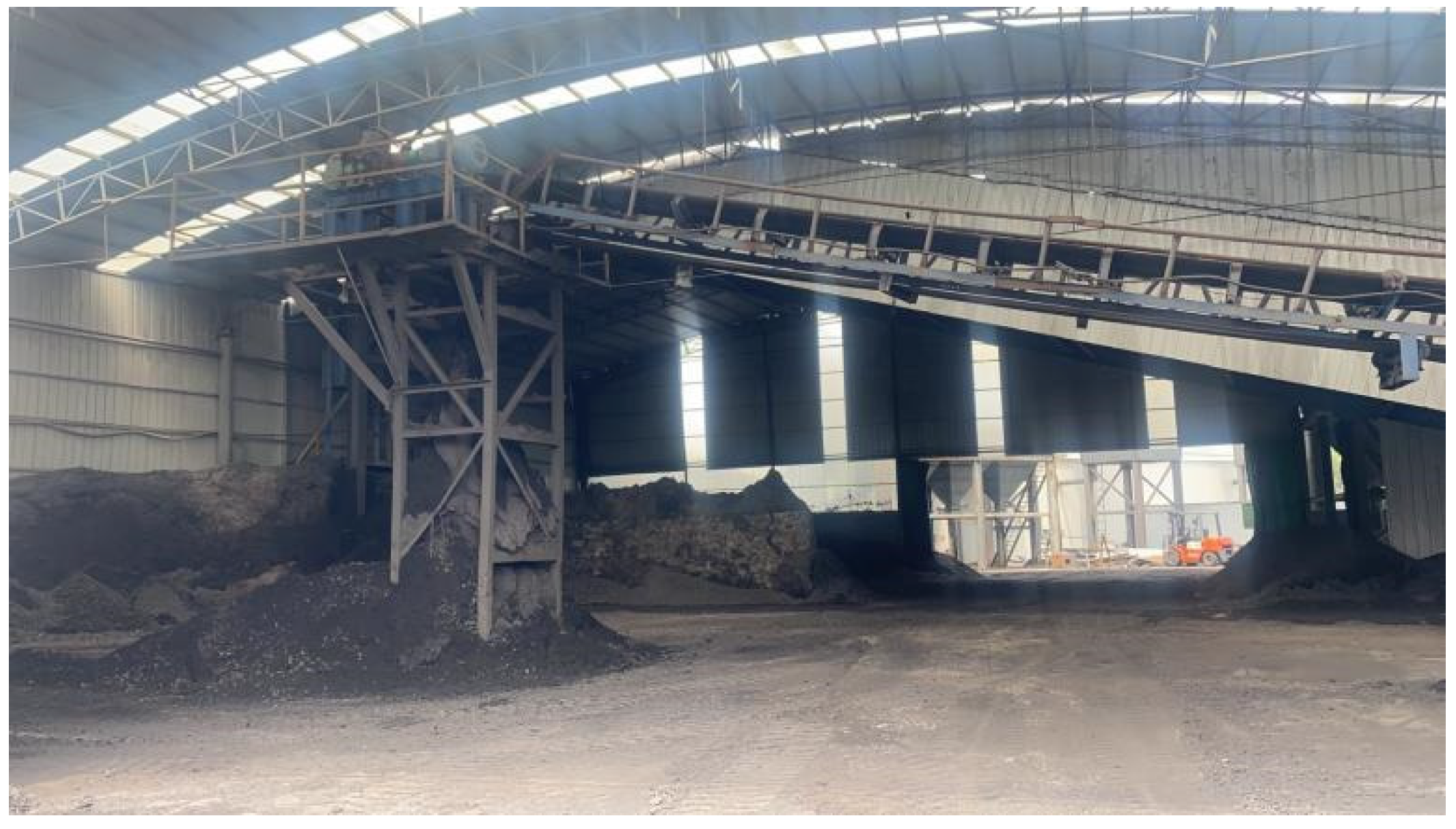

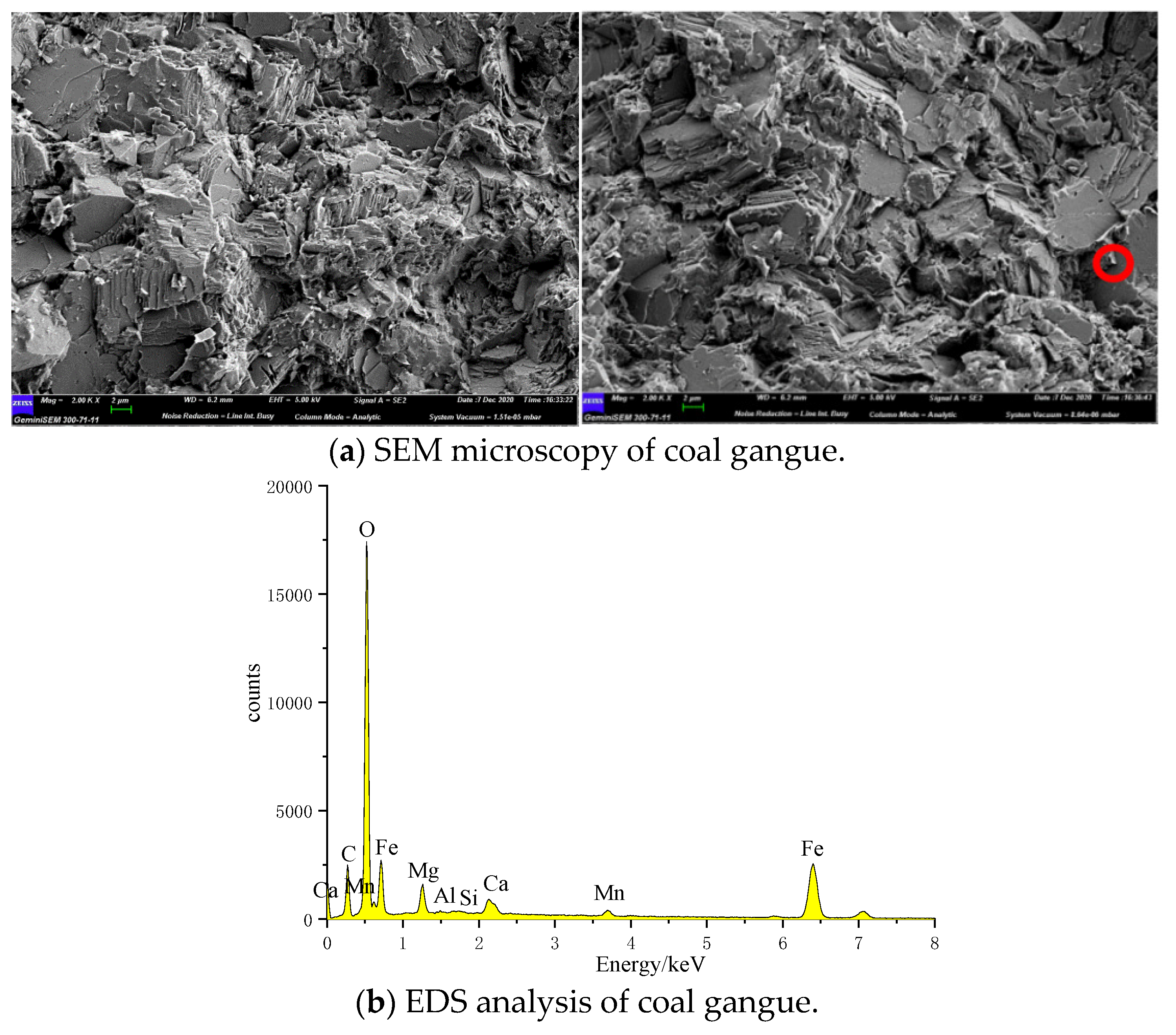
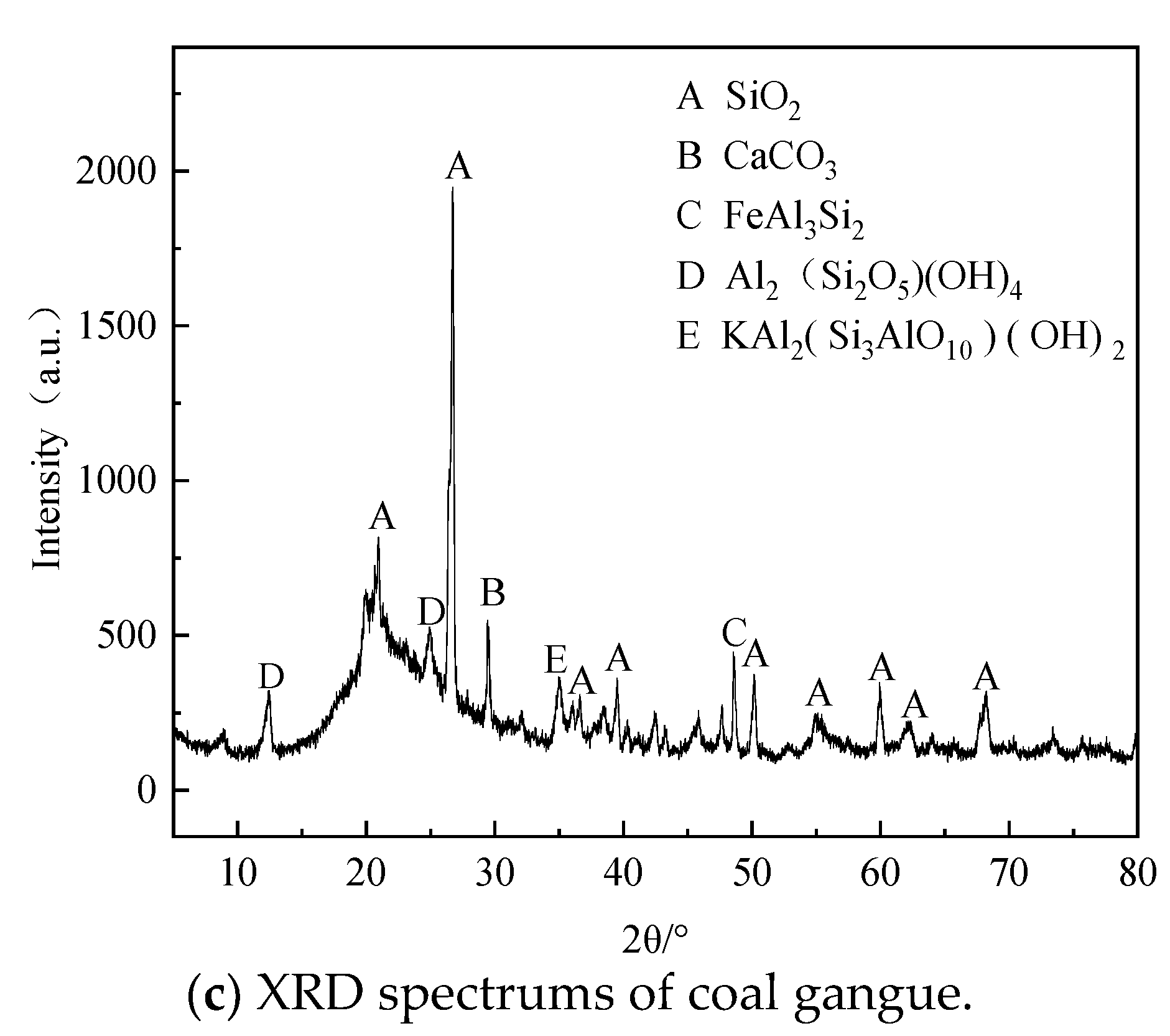

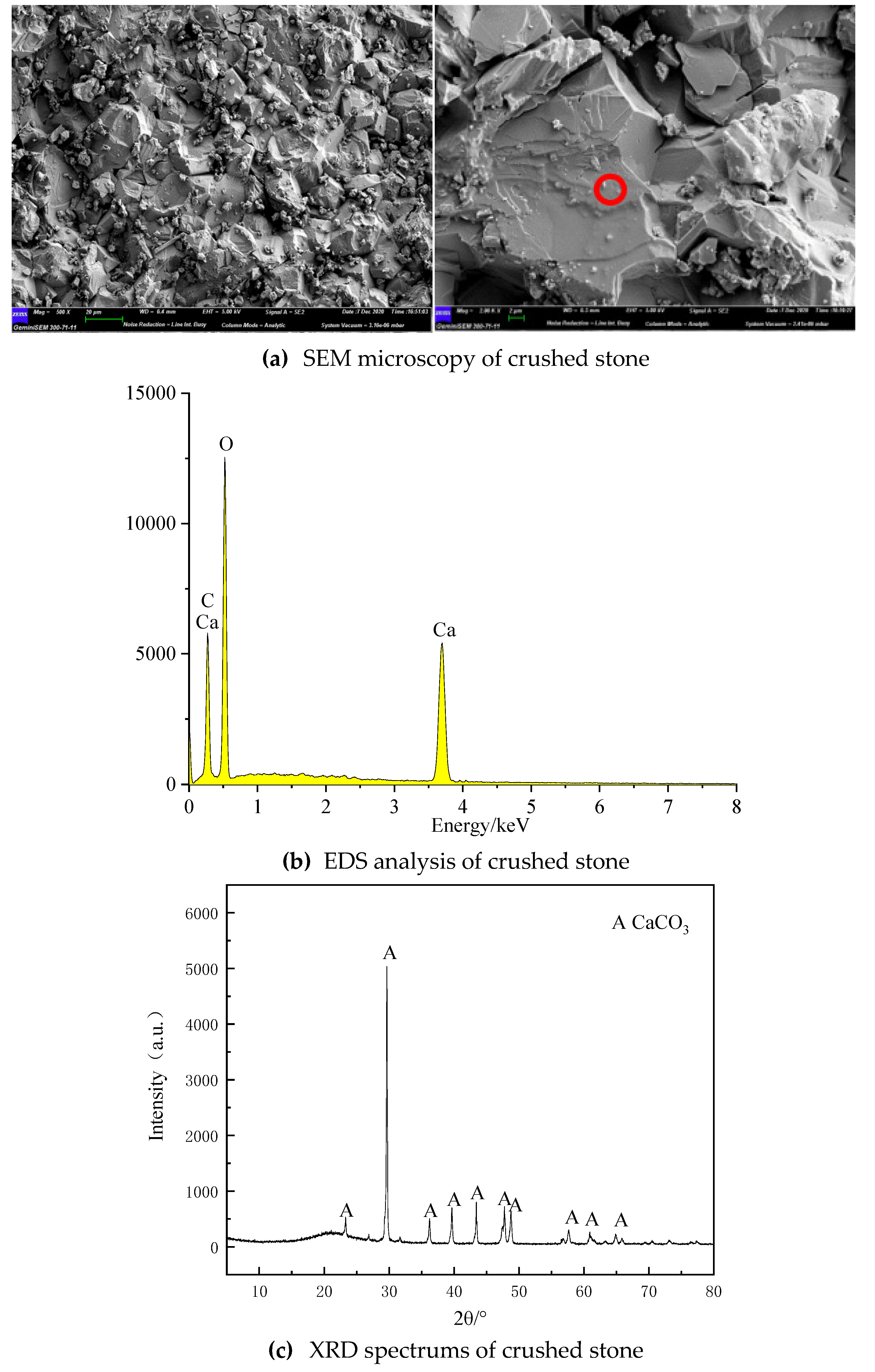
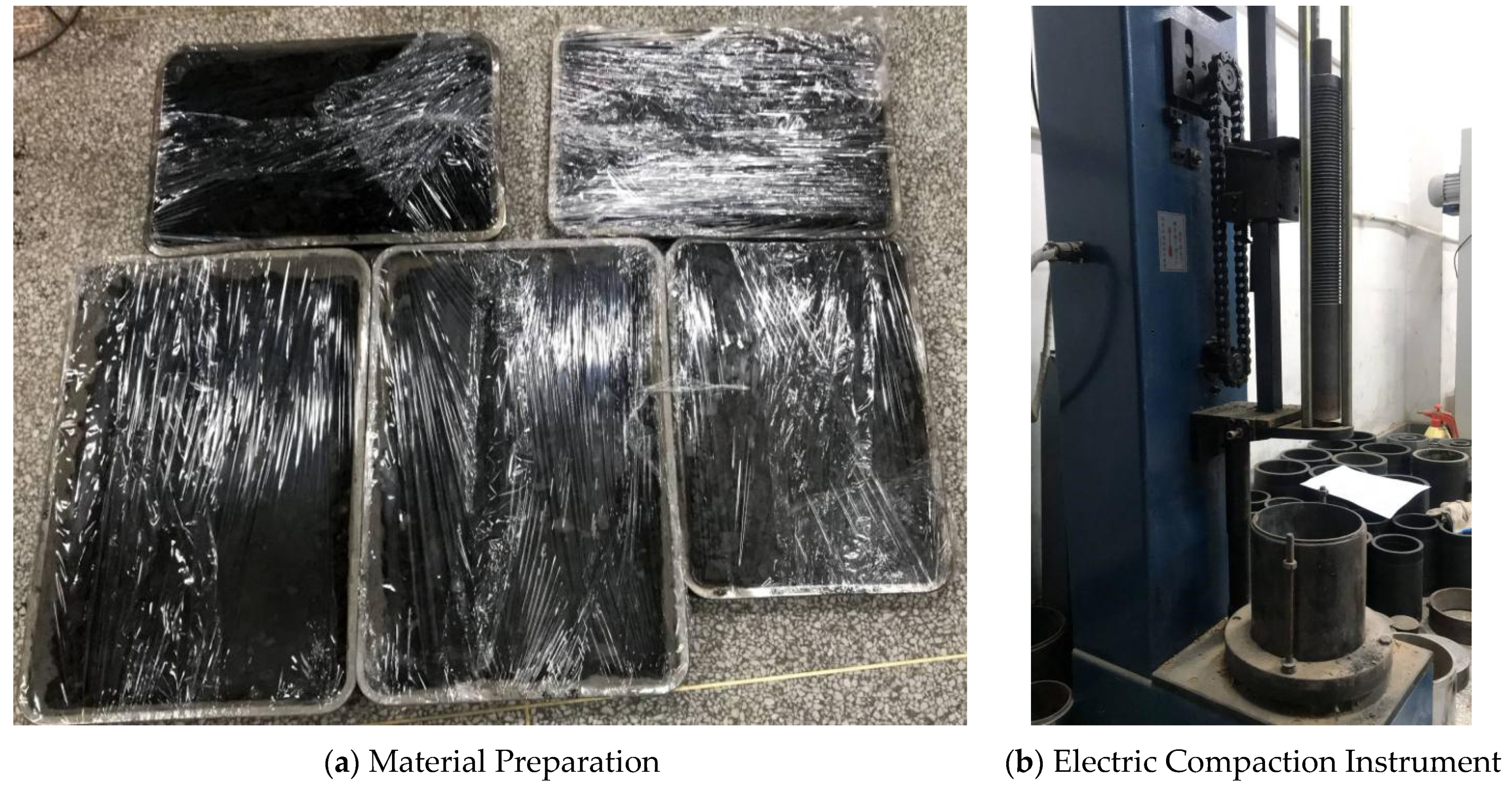

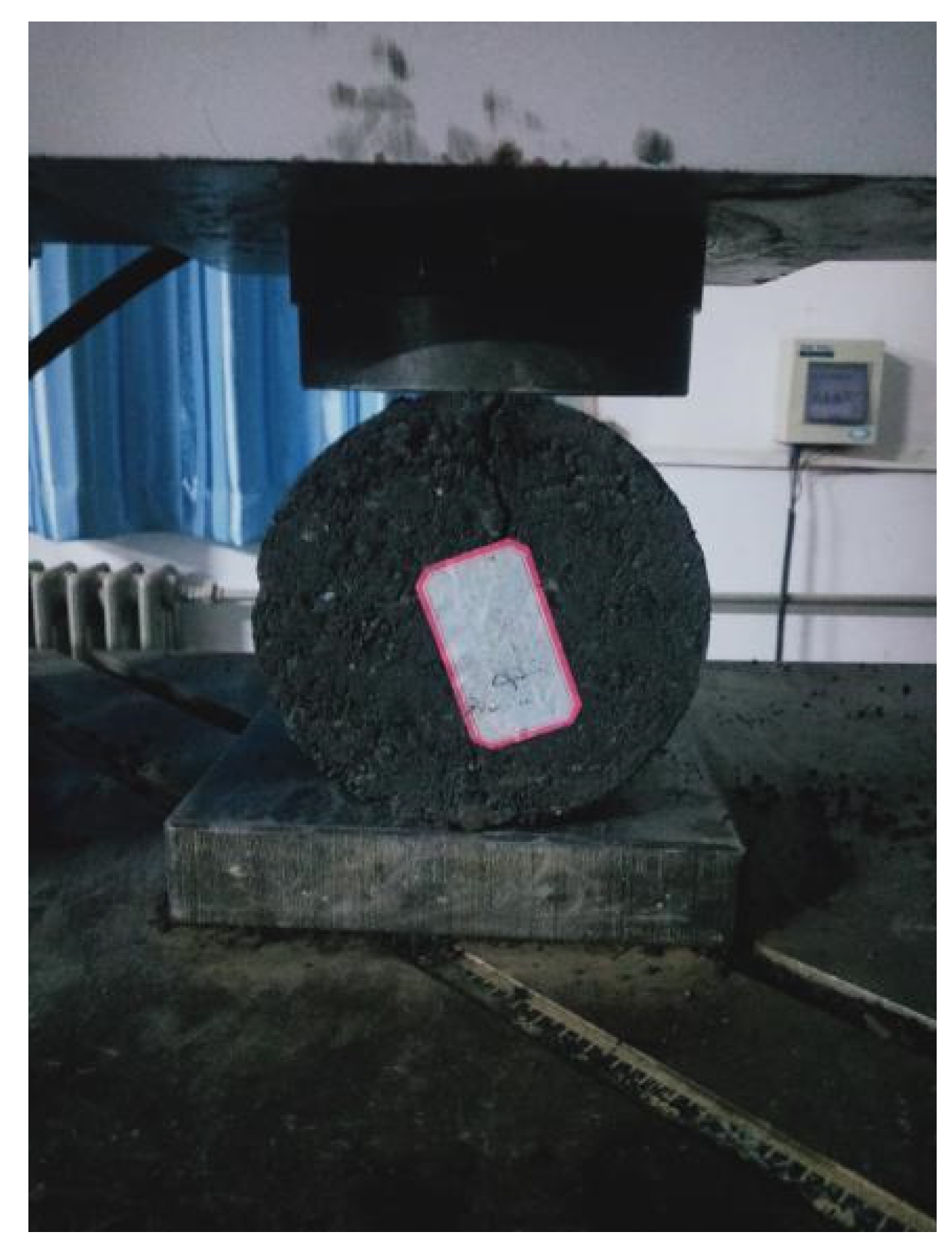
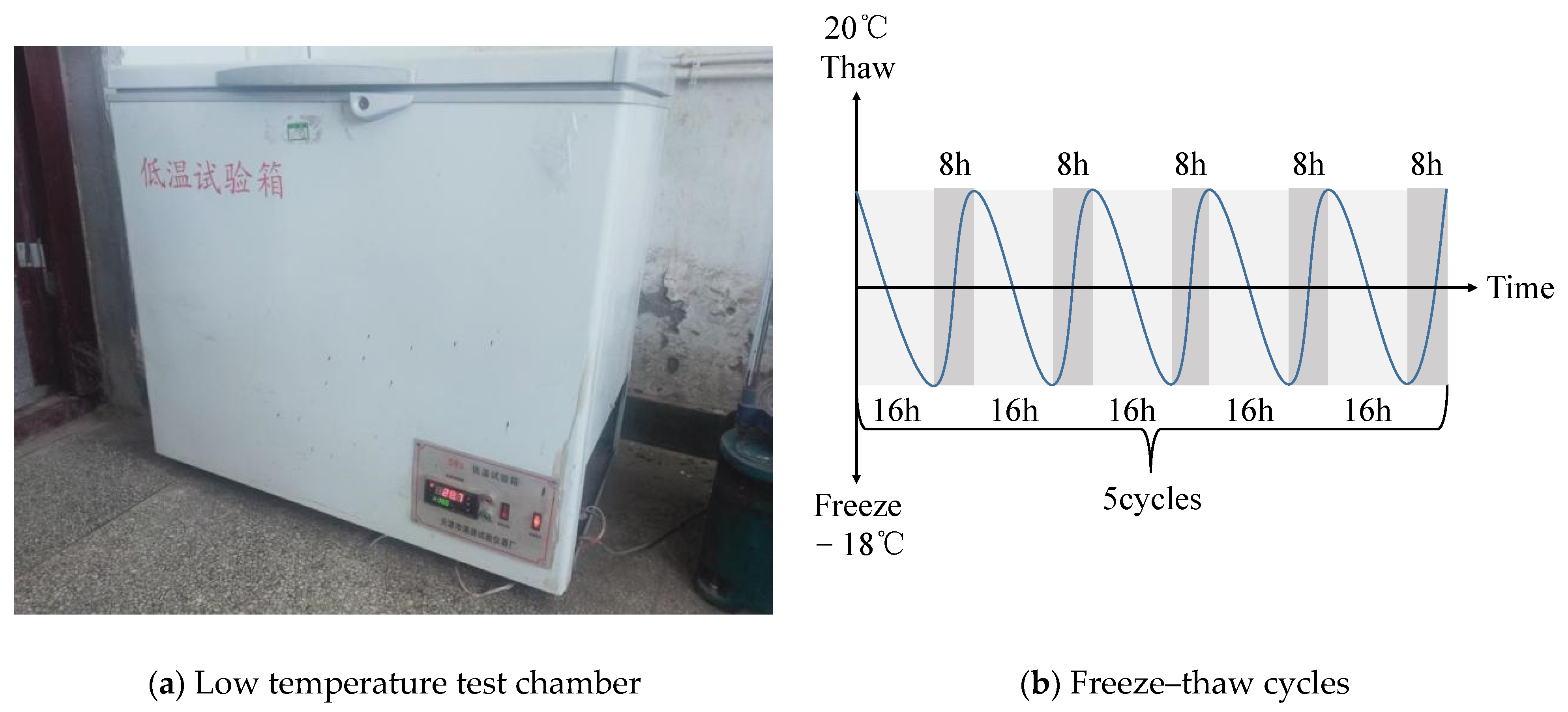


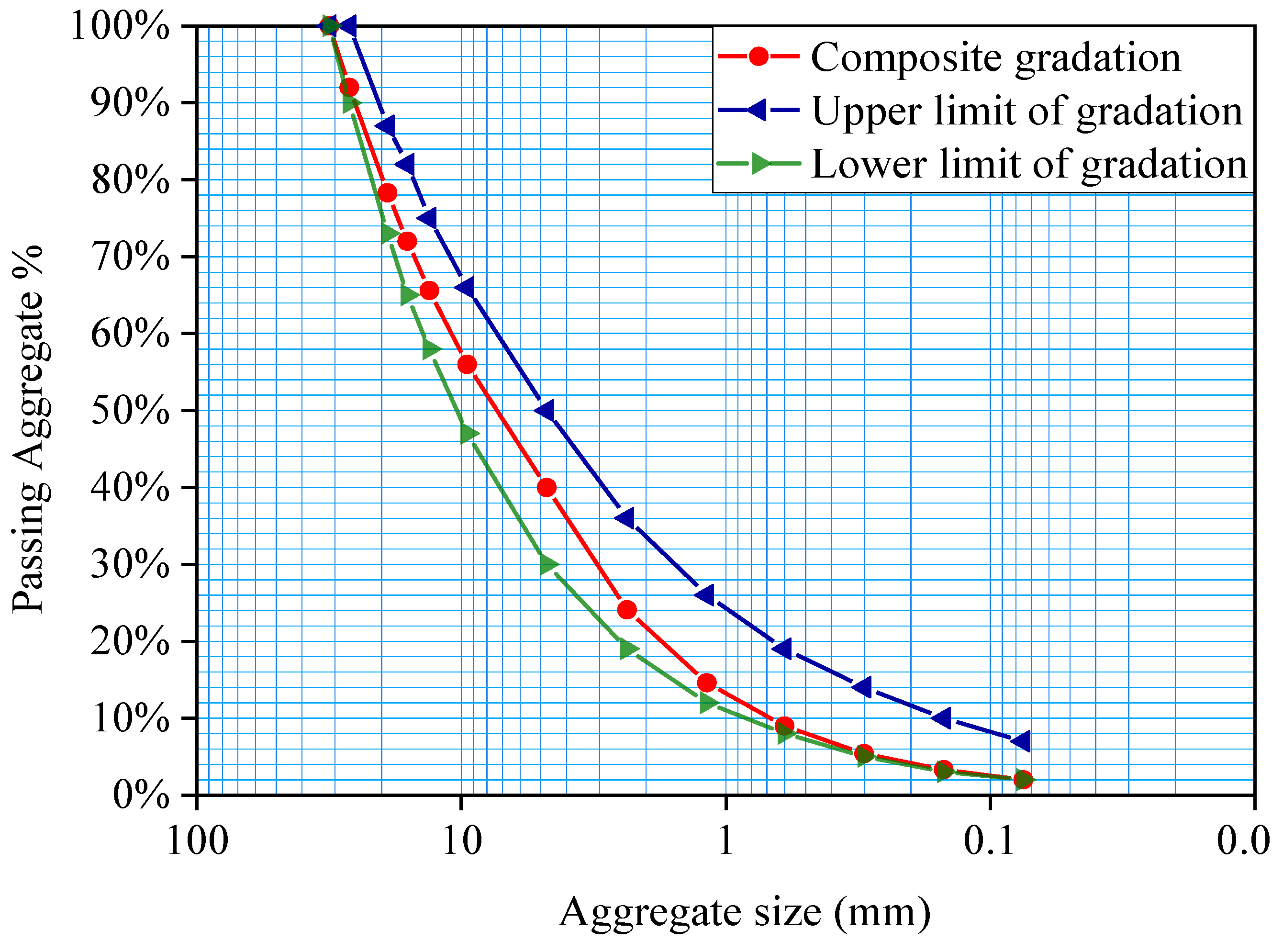
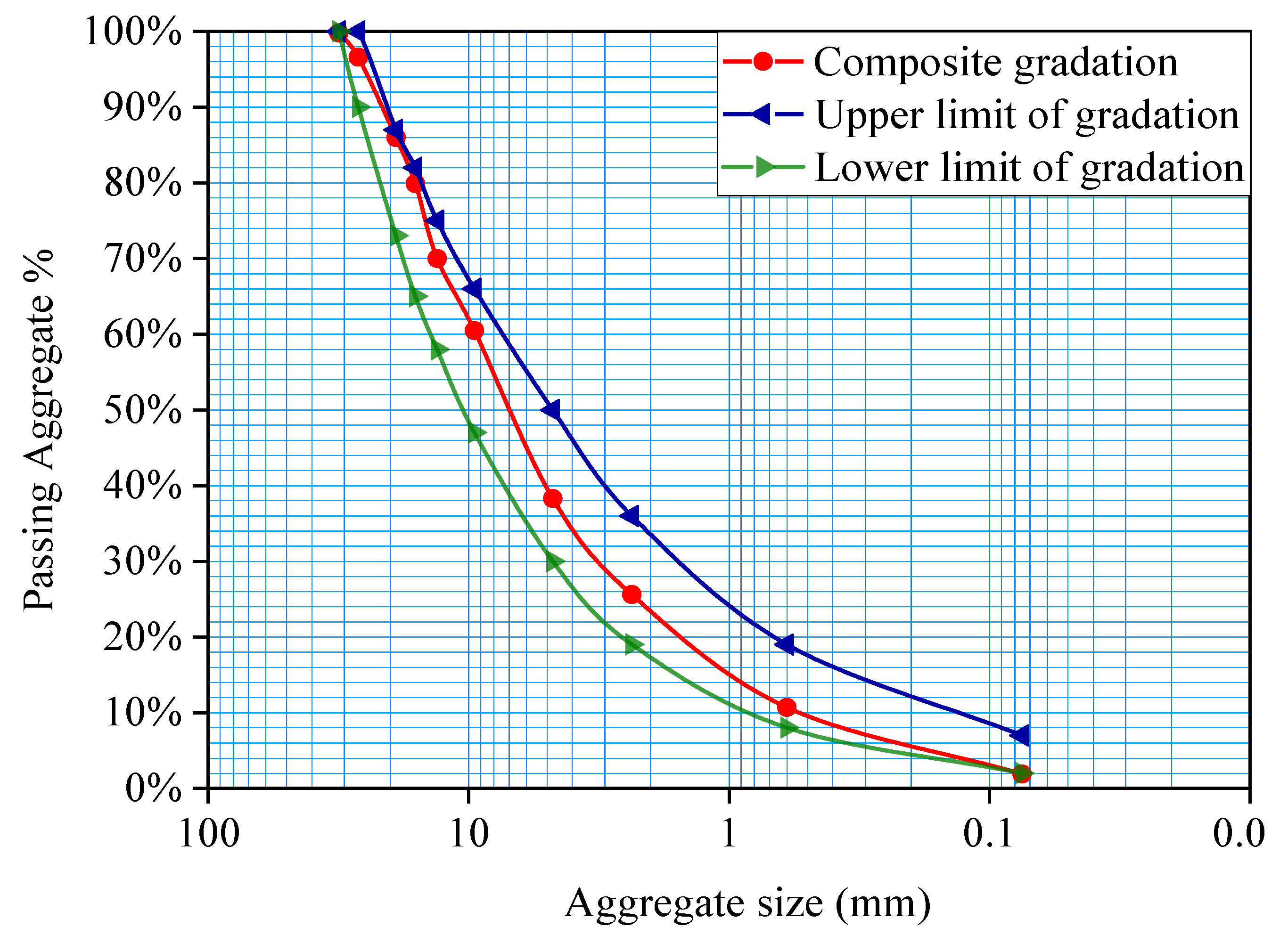
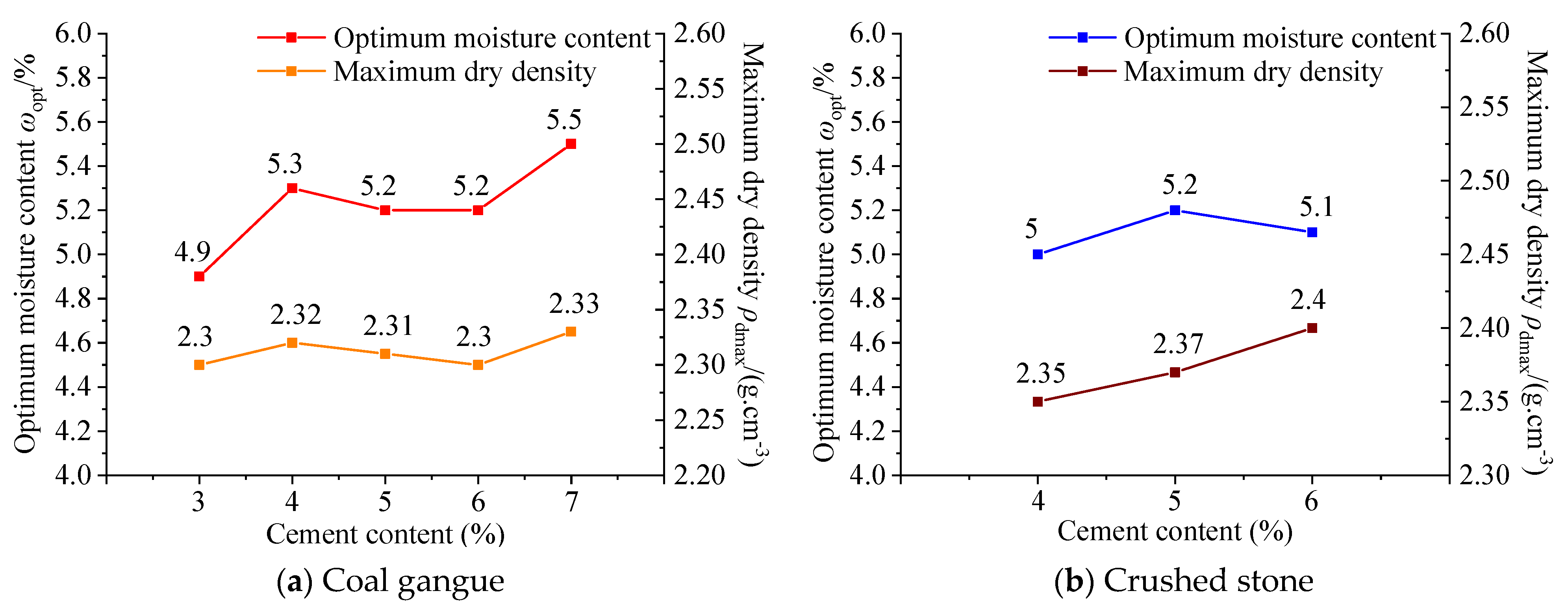
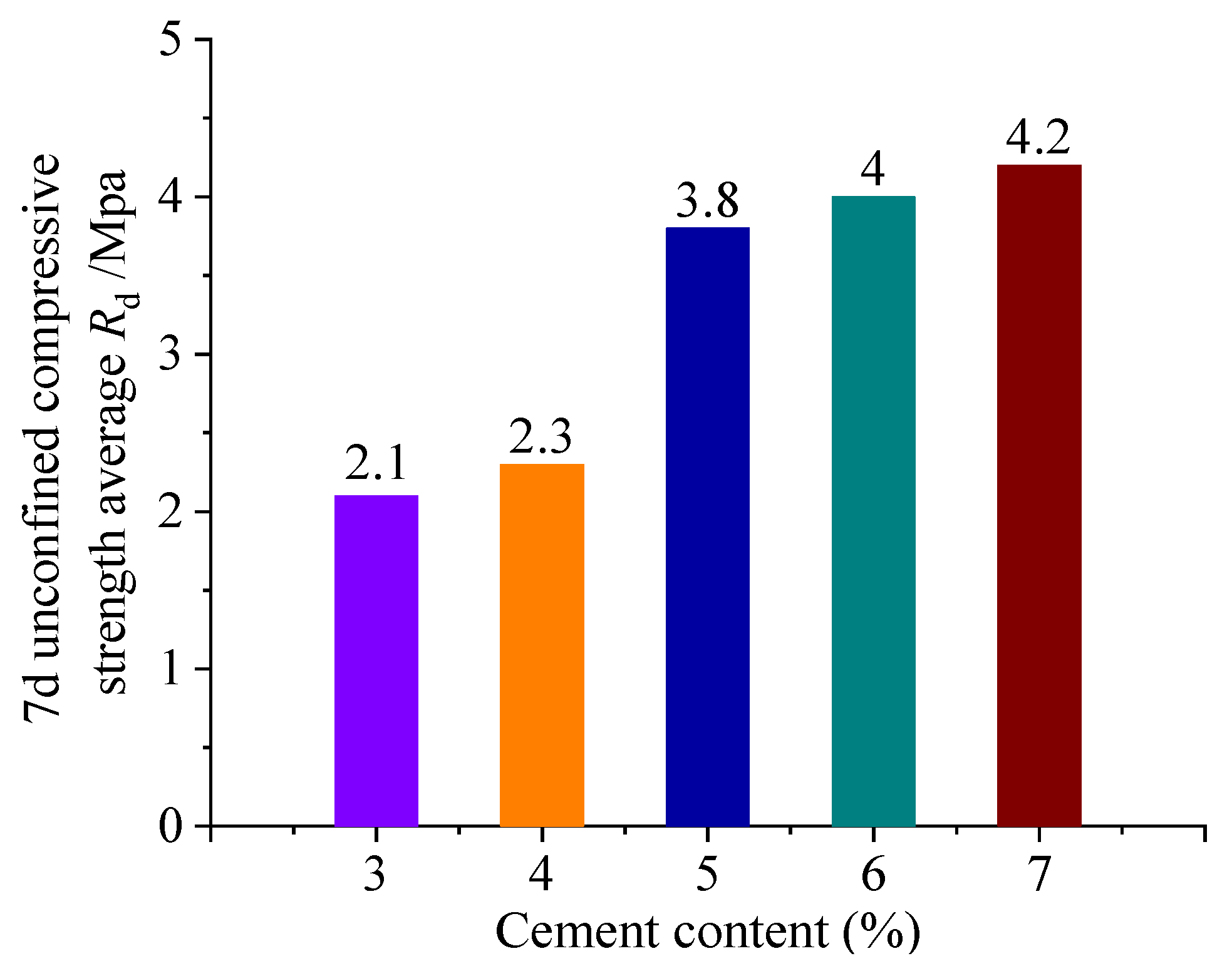

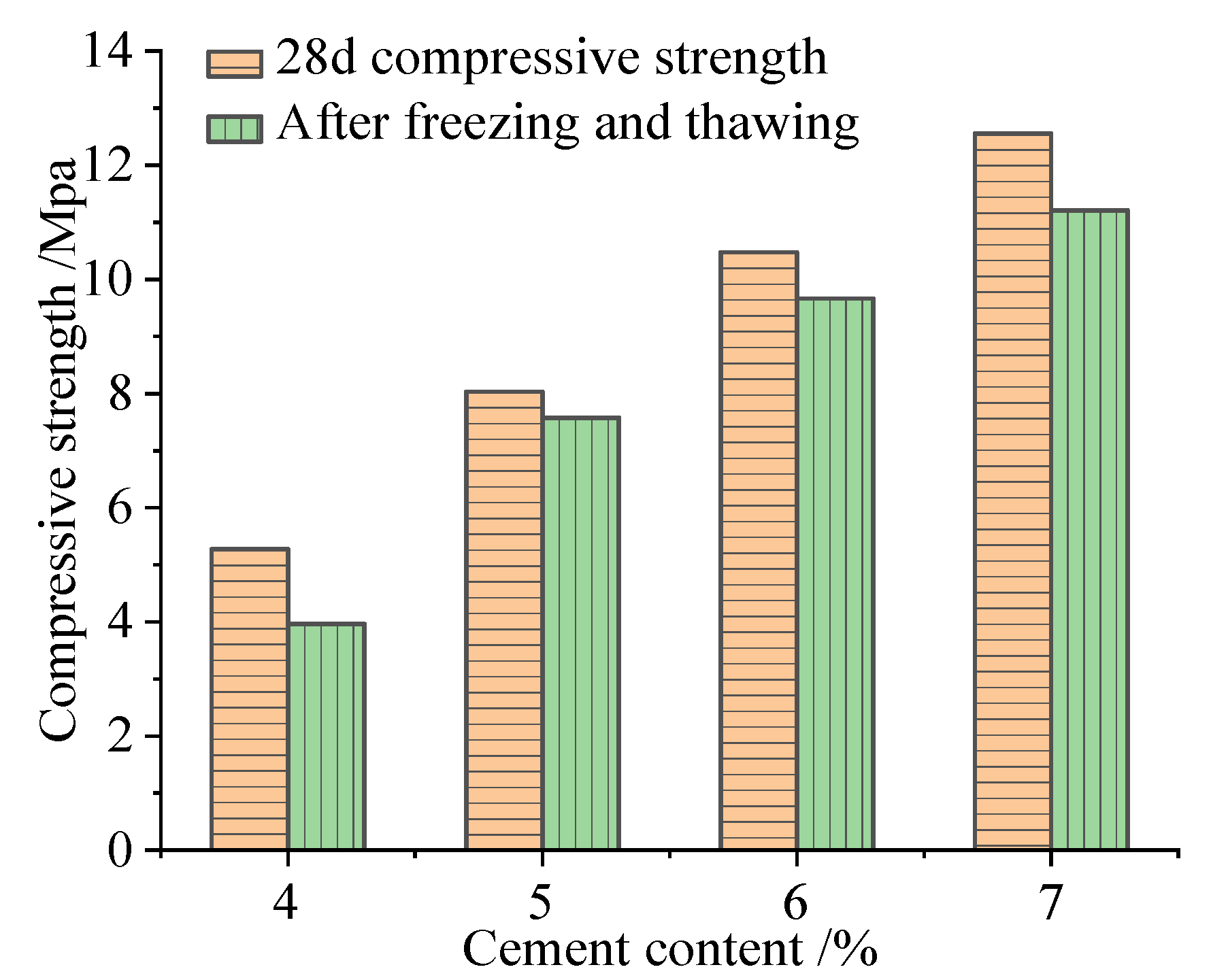
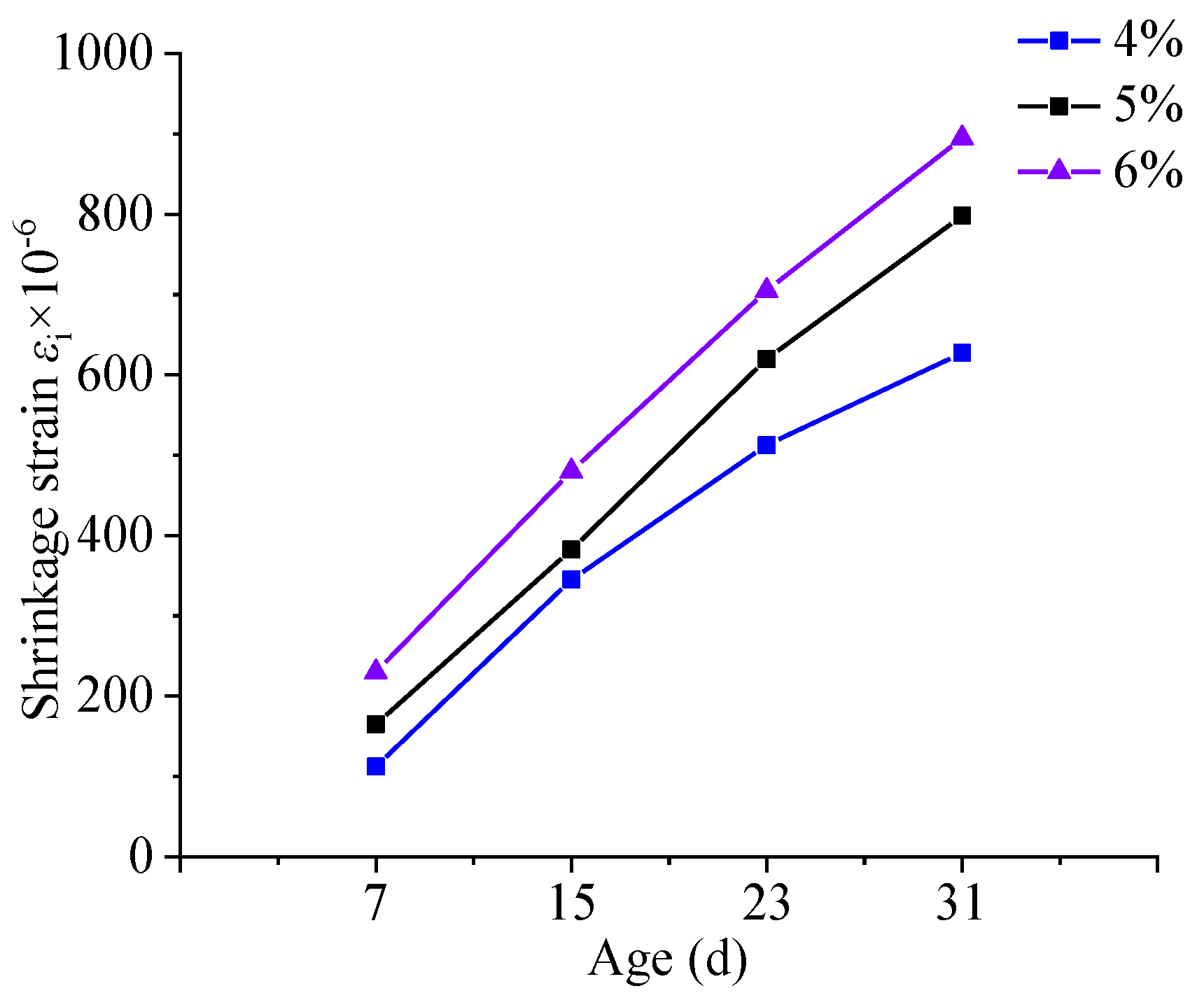
| O | C | Fe | Mg | Ca | Al | Si | Mn |
|---|---|---|---|---|---|---|---|
| 56.6 | 24.2 | 15.2 | 2.2 | 0.9 | 0.4 | 0.3 | 0.2 |
| Apparent Density/g.cm−3 | Bulk Density/g.cm−3 | Porosity/% | Crushing Value/% | Dust Content below 0.075 mm/% | Soft Rock Content/% |
|---|---|---|---|---|---|
| 2.618 | 1.473 | 43.8 | 27.8 | 0.85 | 1.2 |
| Apparent Density/g.cm−3 | Bulk Density/g.cm−3 | Porosity/% | Fineness Modulus | Water Absorption Rate/% |
|---|---|---|---|---|
| 2.74 | 1.507 | 45 | 3.2 | 6.9 |
| O | C | Ca |
|---|---|---|
| 63.6 | 26.3 | 10.1 |
| Apparent Density/g.cm−3 | Bulk Density/g.cm−3 | Porosity/% | Crushing Value/% | Dust Content Below 0.075 mm/% | Soft Rock Content/% |
|---|---|---|---|---|---|
| 2.650 | 1.523 | 42.5 | 25.2 | 0.81 | 1.2 |
| Apparent Density/g.cm−3 | Bulk Density/g.cm−3 | Porosity/% | Fineness Modulus | Water Absorption Rate/% |
|---|---|---|---|---|
| 2.74 | 1.504 | 45.1 | 3.33 | 3.5 |
| Fineness/% | Setting Time (h) | Requirement of Normal Consistency/% | Flexural Strength (MPa) | Compressive Strength (MPa) | |||
|---|---|---|---|---|---|---|---|
| initial | final | 3d | 28d | 3d | 28d | ||
| 3.1 | 3.6 | 6.5 | 28 | 6.9 | 9.4 | 27.6 | 45.8 |
| Sieve Size/mm | 31.5 | 26.5 | 19 | 16 | 13.2 | 9.5 | 4.75 | 2.36 | 1.18 | 0.6 | 0.3 | 0.15 | 0.075 |
|---|---|---|---|---|---|---|---|---|---|---|---|---|---|
| 0–4.75 mm | - | - | - | - | - | - | 100 | 62 | 45.9 | 31.7 | 24.8 | 15.2 | 9.2 |
| 4.75–9.5 mm | - | - | - | - | 100 | 96.8 | 0 | - | - | - | - | - | - |
| 9.5–19 mm | - | - | 100 | 75.9 | 40 | 7.9 | 0.6 | - | - | - | - | - | - |
| 19–31.5 mm | 100 | 71.9 | 6.1 | 3.1 | 2 | - | - | - | - | - | - | - | - |
| Sieve Size/mm | 31.5 | 26.5 | 19 | 16 | 13.2 | 9.5 | 4.75 | 2.36 | 1.18 | 0.6 | 0.3 | 0.15 | 0.075 |
|---|---|---|---|---|---|---|---|---|---|---|---|---|---|
| Passing (%) | 100 | 92 | 78.3 | 72 | 65.6 | 56 | 40 | 24.1 | 14.6 | 9.0 | 5.4 | 3.3 | 2.0 |
| Upper of C-C-2 | 100 | 100 | 87 | 82 | 75 | 66 | 50 | 36 | 26 | 19 | 14 | 10 | 7 |
| Lower of C-C-2 | 100 | 90 | 73 | 65 | 58 | 47 | 30 | 19 | 12 | 8 | 5 | 3 | 2 |
| Sieve size/mm | 31.5 | 26.5 | 19 | 16 | 13.2 | 9.5 | 4.75 | 2.36 | 0.6 | 0.075 |
|---|---|---|---|---|---|---|---|---|---|---|
| Passing (%) | 99.8 | 96.6 | 86 | 79.9 | 70 | 60.5 | 38.3 | 25.6 | 10.7 | 1.9 |
| C-C-2 | 100 | 100–90 | 87–73 | 82–65 | 75–58 | 66–47 | 50–30 | 36–19 | 19–8 | 7–2 |
| Researcher | Cao [39] | Yan [40] | Hu [41] | ||
|---|---|---|---|---|---|
| Cement content/% | 4 | 5 | 4 | 5 | 6 |
| Compressive strength/MPa | 1.92 | 2.69 | 1.81 | 2.34 | 2.92 |
| Cement Content/% | 4% | 5% | 6% | 7% |
|---|---|---|---|---|
| BDR/% | 75.16 | 94.33 | 92.26 | 89.29 |
| Mass loss/% | 0.07 | 0.26 | 0.81 | 0.24 |
| Cement Content/% | Age (d) | |||
|---|---|---|---|---|
| 7 | 15 | 23 | 31 | |
| 4 | 112.5 | 345 | 512.5 | 627.5 |
| 5 | 165 | 382.5 | 620 | 850 |
| 6 | 230 | 480 | 705 | 895 |
Publisher’s Note: MDPI stays neutral with regard to jurisdictional claims in published maps and institutional affiliations. |
© 2021 by the authors. Licensee MDPI, Basel, Switzerland. This article is an open access article distributed under the terms and conditions of the Creative Commons Attribution (CC BY) license (https://creativecommons.org/licenses/by/4.0/).
Share and Cite
Guan, J.; Lu, M.; Yao, X.; Wang, Q.; Wang, D.; Yang, B.; Liu, H. An Experimental Study of the Road Performance of Cement Stabilized Coal Gangue. Crystals 2021, 11, 993. https://doi.org/10.3390/cryst11080993
Guan J, Lu M, Yao X, Wang Q, Wang D, Yang B, Liu H. An Experimental Study of the Road Performance of Cement Stabilized Coal Gangue. Crystals. 2021; 11(8):993. https://doi.org/10.3390/cryst11080993
Chicago/Turabian StyleGuan, Junfeng, Meng Lu, Xianhua Yao, Qing Wang, Decai Wang, Biao Yang, and Huaizhong Liu. 2021. "An Experimental Study of the Road Performance of Cement Stabilized Coal Gangue" Crystals 11, no. 8: 993. https://doi.org/10.3390/cryst11080993






